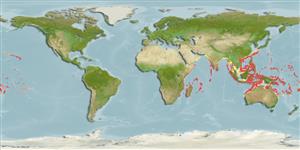Classification / Names
Common names from other countries
Main reference
Size / Weight / Age
Max length : 50.0 cm TL male/unsexed; (Ref. 30573); common length : 35.0 cm TL male/unsexed; (Ref. 30573); max. published weight: 1.8 kg (Ref. 4887)
Environment
Marine; benthopelagic; depth range 70 - 300 m (Ref. 9821), usually 125 - 275 m (Ref. 82366)
Climate / Range
Deep-water, preferred ?; 35°N - 29°S, 34°E - 146°W (Ref. 55)
Distribution
Short description
Dorsal
spines
(total): 10;
Dorsal
soft rays
(total): 10-11;
Anal
spines: 3;
Anal
soft rays: 8. Interorbital space convex. Jaws about equal, or lower jaw slightly protruding. Bases of dorsal and anal fins without scales, their last soft rays extended into short filaments. Pectoral fins long, reaching level of anus. Scale rows on back parallel to lateral line. Overall color pink or reddish with four oblique orange or yellow bars on the sides; the dorsal and caudal fins yellow.
IUCN Red List Status (Ref. 115185)
Threat to humans
Harmless
Human uses
Fisheries: commercial; gamefish: yes
More information
ReferencesAquacultureAquaculture profileStrainsGeneticsAllele frequenciesHeritabilityDiseasesProcessingMass conversion
Tools
Special reports
Download XML
Internet sources
Estimates of some properties based on models
Phylogenetic diversity index
PD50 = 0.5005 many relatives (e.g. carps) 0.5 - 2.0 few relatives (e.g. lungfishes)
Trophic Level
4.0 ±0.0 se; Based on diet studies.
Resilience
Medium, minimum population doubling time 1.4 - 4.4 years (K=0.23)
Vulnerability
Moderate vulnerability (42 of 100)
Price category
